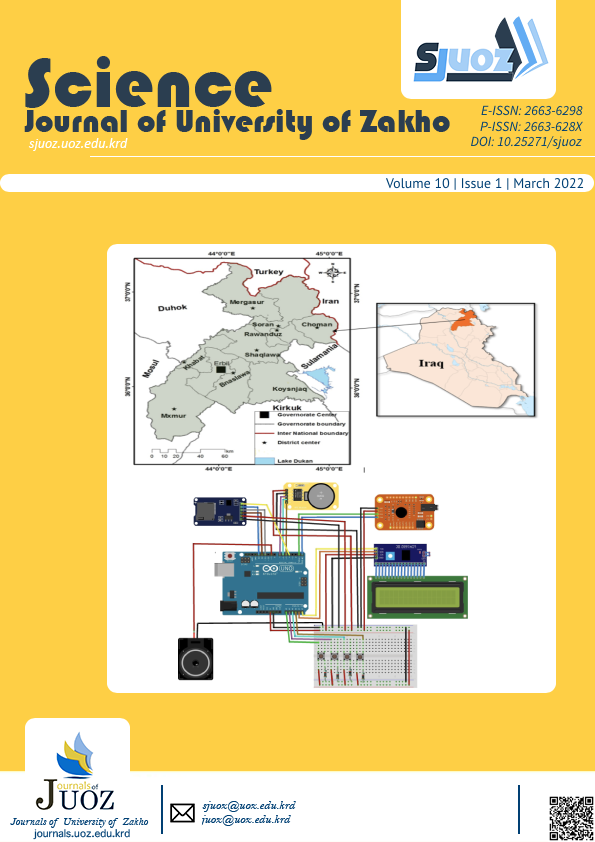Brain Waves Signal Modeling for Object Classification Using Random Forest Method
DOI:
https://doi.org/10.25271/sjuoz.2022.10.1.876Keywords:
Brain Signal, Signal Processing, Machine Learning, Human VisionAbstract
In this research, the connection between human vision information and simultaneous brain signal is studied; to this end, an experiment has been made. Clearly, brain wave signals are captured in the situation that the participants are looking at the specific object. More precisely, the brain signals of 9 shapes are recorded for each participant. Also, 9 participants voluntarily have been involved in the experiment. Then, the collected signals are organised into training and testing groups. After that Random Forest classifier is used to classify the signals.
The accuracy results demonstrate a connection between human vision information and simultaneous brain signal. Overall accuracy for all shapes as separated as per cases is 20.48%, and for shapes, numbers 6 and 8 are 55.34% 36.57%, respectively. It can be concluded that human brain signals can be categorised based on human vision inputs.
Downloads
References
Barroso, H. (2014). An introduction to human neuroanatomy. Academia.edu. Berreskuratua -(e)tik https://www.academia.edu/24696681/An_Introduction_To_Human_Neuroanatomy
Breiman, & L. (2001). Random Forests. 5–32.
Chen, M., Cao, Y., Wang, R., Li, Y., Wu, D., & Liu, Z. (2019). DeepFocus: Deep encoding brainwaves and emotions with multi-scenario behavior analytics for human attention enhancement. IEEE Network, 33(6), 70–77. doi: 10.1109/MNET.001.1900054
Dzaferovic, & E. et al. (2017). Cloud-based mobile platform for EEG signal analysis. International Conference on Electronic Devices, Systems, and Applications. doi: 10.1109/ICEDSA.2016.7818497
Fiscon, G., Weitschek, E., Cialini, A., Felici, G., Bertolazzi, P., De Salvo, S., Bramanti, A., Bramanti, P., & De Cola, M. C. (2018). Combining EEG signal processing with supervised methods for Alzheimer’s patients classification. BMC Medical Informatics and Decision Making, 18(1), 1–10. doi: 10.1186/s12911-018-0613-y
Hima, & C.S. (2015). World Journal of Pharmaceutical Sciences Psoriasis – An Overview. 8(11), 59–66.
Jo, S. Y., & Jeong, J. W. (2020). Prediction of visual memorability with EEG signals: A comparative study. Sensors (Switzerland), 20(9), 1–19. doi: 10.3390/s20092694
K. Rostam, Z. R., & Mahmood, S. A. (2019). Classification of Brainwave Signals Based on Hybrid Deep Learning and an Evolutionary Algorithm. Journal of Zankoy Sulaimani - Part A, 21(2), 35–44. doi: 10.17656/jzs.10755
Khade, D. A., & Ilakiyaselvan, N. (2017). Scene and object classification using brain waves signal. Asian Journal of Pharmaceutical and Clinical Research, 10, 137–139. doi: 10.22159/ajpcr.2017.v10s1.19495
Khosla, A., Khandnor, P., & Chand, T. (2020). A comparative analysis of signal processing and classification methods for different applications based on EEG signals. Biocybernetics and Biomedical Engineering, 40(2), 649–690. doi: 10.1016/j.bbe.2020.02.002
Kim.H, KOEHLER. GJ, & 1995. (1995). Theory and Practice of Decision Tree Induction. 23(6), 637–652.
Nair, A. V., Kumar, K. M., & Mathew, J. (2018). An Improved Approach for EEG Signal Classification using Autoencoder. Proceedings of the 2018 8th International Symposium on Embedded Computing and System Design, ISED 2018, 6–10. doi: 10.1109/ISED.2018.8704011
Onesmus Mbaabu. (2020). Introduction to Random Forest in Machine Learning. Berreskuratua -(e)tik https://www.section.io/engineering-education/introduction-to-random-forest-in-machine-learning/
Pal, C. V., & Leon, F. (2020). A Modified I2A Agent for Learning in a Stochastic Environment. In Lecture Notes in Computer Science (including subseries Lecture Notes in Artificial Intelligence and Lecture Notes in Bioinformatics): Libk. 12496 LNAI. doi: 10.1007/978-3-030-63007-2_30
Sałabun, W. (2014). Przetwarzanie i analiza widmowa sygnałów EEG przy zastosowaniu urza{ogonek}dzenia MindWave MW001. Przeglad Elektrotechniczny, 90(2), 169–173. doi: 10.12915/pe.2014.02.44
Siradjuddin, I. A., Septasurya, R., Sophan, M. K., Ifada, N., & Muntasa, A. (2017). Feature selection with Genetic Algorithm for alcoholic detection using electroencephalogram. Proceedings - 2017 International Conference on Sustainable Information Engineering and Technology, SIET 2017, 2018-Janua, 230–234. doi: 10.1109/SIET.2017.8304140
Tajdini, M., Sokolov, V., Kuzminykh, I., Shiaeles, S., & Ghita, B. (2020). Wireless sensors for brain activity—a survey. Electronics (Switzerland), 9(12), 1–26. doi: 10.3390/electronics9122092
Tonya. (2018). Anatomy of the Brain. Mayfield Clinic Ohio.
Ullah, H., Uzair, M., Mahmood, A., Ullah, M., Khan, S. D., & Cheikh, F. A. (2019). Internal Emotion Classification Using EEG Signal with Sparse Discriminative Ensemble. IEEE Access, 7(c), 40144–40153. doi: 10.1109/ACCESS.2019.2904400
Zheng, W. L., Zhu, J. Y., Peng, Y., & Lu, B. L. (2014). EEG-based emotion classification using deep belief networks. Proceedings - IEEE International Conference on Multimedia and Expo, 2014-Septe(Septmber). doi: 10.1109/ICME.2014.6890166
Zhou, J., Wang, G., Liu, J., Wu, D., Xu, W., Wang, Z., Ye, J., Xia, M., Hu, Y., & Tian, Y. (2020). Automatic Sleep Stage Classification with Single Channel EEG Signal Based on Two-Layer Stacked Ensemble Model. IEEE Access, 8, 57283–57297. doi: 10.1109/ACCESS.2020.2982434.
Downloads
Published
Issue
Section
License
Copyright (c) 2022 Younus H. Mala, Mahmud A. Mohammad

This work is licensed under a Creative Commons Attribution 4.0 International License.
Authors who publish with this journal agree to the following terms:
- Authors retain copyright and grant the journal right of first publication with the work simultaneously licensed under a Creative Commons Attribution License [CC BY-NC-SA 4.0] that allows others to share the work with an acknowledgment of the work's authorship and initial publication in this journal.
- Authors are able to enter into separate, additional contractual arrangements for the non-exclusive distribution of the journal's published version of the work, with an acknowledgment of its initial publication in this journal.
- Authors are permitted and encouraged to post their work online.





